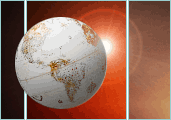Summer Solstice for Kids

In 2017, summer begins June 21, 12:24 A.M. EDT (04:34 UT*)
by Karen Barss
 Related Links |
Did you ever wonder why the days are so long in the summer and so short in the winter? The length changes throughout the year. In the summer, around June 20 or 21, we experience the summer solstice, which is the longest day of the year. And in the winter, December 21 or 22 is the winter solstice, or shortest day.
But wait! If you live in Australia, you experience the opposite—the longest day is in December and the shortest is in June. Why?
Earth's Angle
The answer all depends on Earth's tilt. In the course of one year, Earth orbits around the sun. It does not complete this trip, however, with the North Pole at the top and the South Pole at the bottom because Earth is tilted. In fact, it's tilted just about 23.5 degrees. So at different times of the year, either the northern or the southern hemisphere is tilted toward and is therefore closer to the sun.
So if you live in the northern hemisphere (north of the equator), Earth is tilted toward the sun in the summer and away from the sun in the winter. The solstice marks the turning point, when the days begin to grow longer (in the winter) or when they begin to grow shorter (in the summer). At the solstice itself, however, the sun appears to stand still in the sky for a few days before and after. The word solstice, in fact, comes from the Latin for sun + to stand still.
Reasons for Seasons
But then why, if the solstice is the turning point, is June 21st considered the first day of summer and December 21st the first day of winter? This odd fact is because while the hours of daylight are changing, the oceans need to catch up. Oceans take a long time to heat up and cool down (something called thermal inertia). In June, they are still cool from the winter, so the warmest days happen in July and August. (Have you ever gone swimming off Cape Cod in June? Brrrr!) Similarly, the oceans hold onto the warmth of summer long after the barbeques have ended. So the coldest days usually happen in January and February. (Again, everything is reversed if you live below the equator.)
Even stranger, Earth is closest to the sun between January 3 and 5, but since the northern hemisphere is tilted away from the sun, the nights are long and the weather is cold.
Celebrating the Solstice
People from many different cultures have held solstice celebrations for thousands of years. For our distant ancestors, dependent on hunting, gathering, and growing, the seasons and the weather played a central role in their lives.
In the northern hemisphere, passing the winter solstice meant the return of the sun, which seemed to be disappearing. Many religious and cultural traditions celebrated the rebirth of sunlight after this dark period. The summer solstice, on the other hand, was a time to celebrate renewal, life, fertility, and the potential for a good harvest. It was celebrated through outdoor feasts with singing, dancing, and bonfires.
Building on the Solstice
Ancient buildings have long reflected people's fascination with the sun. Stonehenge is perhaps the best known of these stone structures. Another prehistoric stone building, in Newgrange, Ireland, and dating from about 3,300 BCE, allows sunlight to penetrate to the back of the cairn only at sunrise on the winter solstice. The neolithic cairn at Maeshowe on the Orkney Islands lets in the setting sun on the same day. And the Bighorn Medicine Wheel in Wyoming, one of 40 or more similar "wheels" found in the Rocky Mountains, serves a similar astronomical function.
